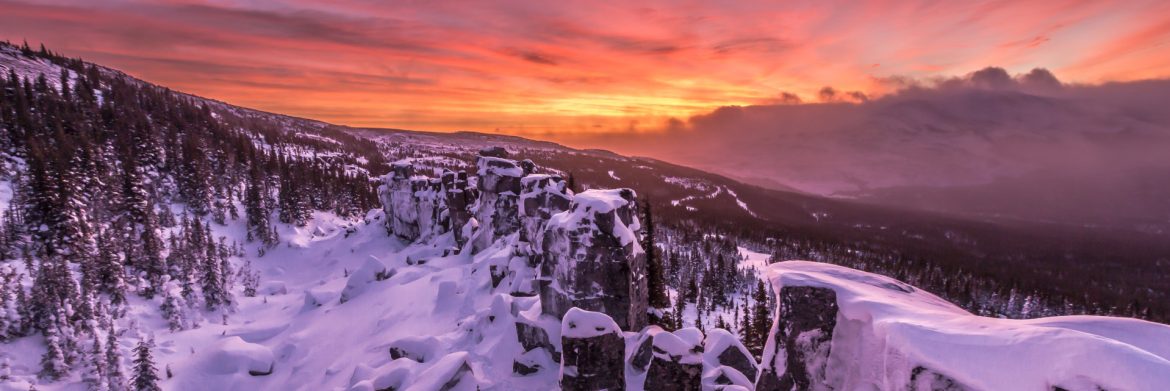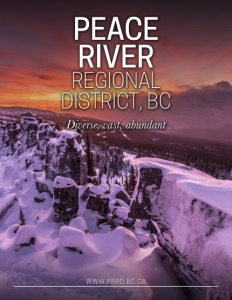Peace River Regional District, BC
Diverse, vast, abundant
Business View Magazine interviews Brad Sperling, Chair of the Peace River Regional District Board, for our focus on Infrastructure in British Columbia.
The Peace River Regional District (PRRD) is the largest regional district in British Columbia, comprising 13 percent of the province’s total area. At 46,023 miles, it is similar in area to the State of Pennsylvania or New Zealand’s North Island. Located in northeastern B.C., the regional district comprises seven municipalities (cities of Fort St. John and Dawson Creek; and district municipalities of Tumbler Ridge, Chetwynd, Taylor, Hudson’s Hope, and the village of Pouce Coupe) and four electoral areas. The district’s administrative offices are in Dawson Creek. Six Indian reserves and one Indian settlement are located within the district’s boundaries, but are not governed by the regional district.
The Peace River Regional District has seen continued growth over the years, with its strong economy attracting many young, energetic residents. Diverse economic drivers include industries such as agriculture, tourism, manufacturing, oil and gas, hydro-electric power generation, forestry, and mining. This vibrant economy combined with affordable housing allows younger residents to become homeowners – an opportunity they might not have available in the lower mainland and Vancouver. Many people come to the Peace River Region for short-term employment but become long-term residents due to the vast amount of economic and recreational offerings in the region. Its vast, abundant landscape attracts locals and tourists, alike, for a variety of outdoor pursuits.
The PRRD has strong partnerships with industry and believes in balancing economic activities with environmental protection. The Farmington Working Group of residents, the BC Oil & Gas Commission, and industry partners exists to ensure residents in the area are able to live and work with industrial partners. In that regard, they are focusing on building strong relationships with First Nations Partners to move forward together as they work towards the betterment of the region for everyone. Collaboration and sharing solutions is vital for remote and rural communities and includes looking outside regional borders, as well. Establishing key intergovernmental and interprovincial partnerships with communities in Alberta and beyond can help further ensure sustainability for everyone in the PRRD region.
While many people choose to live in the Peace River RD due to the vast, beautiful landscapes and peaceful, remote communities, the region faces many unique issues that those in southern urban settings have difficulty comprehending. One of the district’s strategic focus areas is to advocate at the provincial and federal level to afford citizens the same rights and opportunities they would get in other parts of the province. Current items in that regard include: remote communities without broadband connectivity; seniors’ housing; and emergency response capacity for local government responsive service delivery.
The Peace River Regional District has a diverse and growing tourism industry that has brought many new, exciting events and opportunities to the region. Sports Tourism is producing many world-class athletes, and the region has integrated major infrastructure projects to promote that particular tourism vein. Items of note: the Pomeroy Sports Centre – Olympic Sized Speed Skating Track (hosted Chinese Olympic team earlier in 2019); North Peace Leisure Pool; Encana Events Centre (attracts world-class entertainment events); and the Chetwynd & District Rec Centre. The PRRD is also home to the Tumbler Ridge Global Geopark, first designated as a UNESCO Global Geopark in 2014. The TRUGG highlights some of the geological significance of the area and has positively impacted tourism for the entire region. Also famous for important paleontological discoveries, Tumbler Ridge is home to an impressive Dinosaur museum and several hiking trails with real dinosaur footprints that immerse visitors in the surreal, natural experience.
Brad Sperling, Chair of the PRRD Board, elaborates, “Fort St. John has a population over 20,000; Dawson is 15,000 so there are plenty of hotels. And Tumbler Ridge and all the smaller communities have good facilities, including provincial and local camps. Tourism is something that the Regional District and its member communities work very hard on. And, of course, we have the world-famous Alaska Highway which starts at Dawson – mile zero. So, we still get a lot of American tourists coming up, but we’re starting to see more Canadian tourists, as well. It’s almost a staycation. The scenery and the country up here is fantastic.”
But as busy as the tourism sector is, it isn’t a major economic driver for the region. Those are agriculture, forestry, and the oil and gas industry. On the energy front, The Coastal Gaslink project will begin with one compressor station at Wilde Lake in Groundbirch, B.C., to the LNG Canada Facility in Kitimat. The workload is split into eight sections – of which, sections one and two fall in the Peace Region. According to Sperling, “We are more or less at the center of the LNG; it’s another four or five years off before it’s completed to the coast. We’ve got good growth right now, slow but steady. So that gives us time to look at infrastructure, facilities, and, basically, build and prepare for it in a good steady manner.”
The average population age in the Peace River Regional District is 35 years old and keeping those young people is a challenge at times because of competition from larger centers that may have more or better infrastructure. But the abundant employment and community opportunities give Peace River RD the edge. Young people working in the oil and gas industry can make an excellent wage, and that’s attractive. Sperling relates, “I think that for the young people who are either moving here, or growing up here and staying, it’s not the city life they want. They like the rural or smaller community and that’s a big part of it. They’re looking for a different lifestyle other than the hustle and bustle of the city. The trails, the camping, and, in the winter, the Pomeroy Sports Centre in Fort St. John with its walking track, the arenas, leisure pool – and Dawson and Chetwynd have similar amenities. It’s very much an outdoor attitude but then, because of our climate, there are a lot of indoor facilities as well.”
Broadband connectivity is a challenge; however, it is improving. The PRRD is currently doing a needs assessment to understand what is needed, especially in the rural areas. These assessments are also necessary to apply for grants. There are several service providers in the area, it’s just a matter of identifying what is economically feasible for the District. “We will have population growth, and we need to prepare for it,” says Sperling. “Right now it’s steady and I don’t think we’ll see a huge rise until the LNG pipeline actually starts processing and shipping the gas out.”
Another challenge concerns healthcare. Attracting and retaining nurses is an issue, so the RD and the municipalities lobbied the provincial government for advance education for nurses. The good news is that those efforts were successful and in two years there will be a nursing school located in Fort. St. John. Northern Lights College already has a campus there and in Dawson. And the University of Northern BC has a campus in each of those towns, as well. When it comes to environmental sustainability, there are between 400 and 600 wind turbines in the Peace River Regional District that tie into the main hydro grid. The District has also been putting solar panels on all the public buildings, and working hard to improve recycling, even though it’s very expensive to ship those materials out of the region for processing.
Sperling notes, “I want to give a shout out to the whole district and the 12 members that sit on that Board. They’re a great bunch, very strong, and I couldn’t have done the job as Chair for the last 3 ½ years without them. All seven community mayors are on the Board and we all work very hard at trying to move forward, and on understanding and building relationships. As part of that, we’re forming and working on partnerships with our First Nations neighbors, they are very important to our local communities. Looking ahead, I’d like to see more and stronger relationships with our First Nations, without a doubt; and a lot more partnerships between the member municipalities and the rural areas in the District and I think that will be achieved. There will be a lot more joint infrastructure put into place over the next five to ten years.
“Number one in importance about Peace River RD is the people. Whether you’re older like I am, or the younger demographic, it’s comforting; a hardworking, comforting place where neighbors help neighbors. Our tagline – diverse, vast, abundant – is what we really are. It’s incredible.”
*Armada Ridge photo at top courtesy of Collin Ball
AT A GLANCE
Who: Peace River Regional District, British Columbia
What: Largest regional district in the province; pop. approx. 63,000
Where: Northeastern B.C.
Website: www.prrd.bc.ca
PREFERRED VENDORS
Aquatech Canadian Water Services – rschlachter@aquatech-canadian.com


